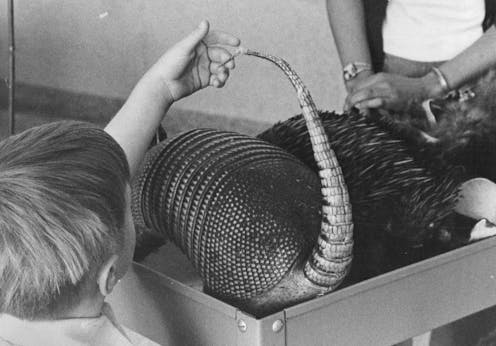Leprosy-causing bacteria found in armadillo specimens highlight value of museum collections for tracking pathogens
- Written by Daniel Romero-Alvarez, Ph.D. Candidate in Ecology of Infectious Diseases, University of Kansas

The Research Brief[1] is a short take about interesting academic work.
The big idea
Years-old tissue samples from armadillos in museum collections[2] may harbor Mycobacterium leprae, the bacteria that causes Hansen’s disease[3], also called leprosy, according to recent research my colleagues and I[4] conducted.
Leprosy can cause nerve damage[5] that, without early effective treatment, can lead to paralysis and blindness in the most severe cases. Approximately 140,000 new patients were diagnosed[6] worldwide in 2021, mostly concentrated in India, Brazil and Indonesia. Since 2010, evidence has accumulated that the nine-banded armadillo, Dasypus novemcinctus, is transmitting leprosy to people in North America[7] and potentially elsewhere[8].
To investigate this connection, we turned to 10 natural history museums in the U.S. These institutions offer more[9] than just public exhibitions. They also host thousands of biological samples, collected over many years. Examining these historical specimens could help researchers identify pathogen prevalence and diversity across time and space.
In our study, we used online repositories such as VertNet[10] to identify armadillo specimens held by museums. We then physically examined tissue samples from 159 individual animals from 10 armadillo species. Specimens were collected between 1974 and 2017 from eight countries in the Americas.
Using molecular diagnostic techniques, we identified M. leprae bacteria in muscle, spleen and liver tissues in 18 out of 122 nine-banded armadillos – a prevalence of 14.8%. All positive samples were collected between 1996 and 2014. Our research allowed us to peek into the immediate past to see that M. leprae was circulating in armadillos in previously unknown locations.
Why it matters
How leprosy is transmitted is still under debate. The bacteria can apparently spread in aerosols and droplets released by the coughs or sneezes[11] of infected patients. But because some people become sick without being exposed to an infected person or traveling to an area where leprosy is present, researchers think there must be another way it spreads[12].
In the last decade, molecular examinations of nonhuman samples, water and soils have suggested that wildlife and the environment are potential sources of leprosy[13]. Our analysis revealed that the M. leprae strain identified in the positive museum samples is very similar to one that has been circulating in North American armadillos since the 1990s, when transmission of leprosy through wildlife was still only suggested[14].
What other research is being done
In animals, researchers have used museum specimens to study snake fungal disease[15] and the chytrid fungus that affects frogs[16].
Scientists less often examine museum archives for pathogens that affect humans[17]. Researchers have, however, identified Tripanosoma cruzi, the agent that causes Chagas disease, in wood rats[18] in natural history museum collections, as well as hantaviruses in deer mouse[19] specimens.
Since approximately 70% of emerging human infectious diseases originate in wildlife[20], examining museum specimens will likely help identify where and when particular pathogens have existed. Ultimately, understanding more about which pathogens are emerging, and where – as we did with leprosy and armadillos – can help scientists anticipate potential outbreaks and maybe even head them off.
What still isn’t known
Scientists discovered in 2008 that another pathogen, Mycobacterium lepromatosis, can also cause leprosy[21]. Researchers have yet to untangle the role of this second bacteria in the worldwide incidence of the disease.
All our 159 armadillo samples were negative for M. lepromatosis. But this bacteria has infected humans in Mexico, Colombia, Canada and elsewhere[22], along with red squirrels in the British Isles[23].
My colleagues and I hope our discovery[24] prompts further research on the role of nonhuman sources of leprosy transmission across the Americas. Our work[25] is another case study demonstrating that natural history collections can play an important role[26] in human infectious disease research.
References
- ^ Research Brief (theconversation.com)
- ^ armadillos in museum collections (doi.org)
- ^ bacteria that causes Hansen’s disease (www.cdc.gov)
- ^ and I (scholar.google.com)
- ^ Leprosy can cause nerve damage (www.niaid.nih.gov)
- ^ 140,000 new patients were diagnosed (apps.who.int)
- ^ transmitting leprosy to people in North America (doi.org)
- ^ elsewhere (doi.org)
- ^ These institutions offer more (doi.org)
- ^ VertNet (vertnet.org)
- ^ released by the coughs or sneezes (doi.org)
- ^ another way it spreads (doi.org)
- ^ sources of leprosy (doi.org)
- ^ was still only suggested (doi.org)
- ^ snake fungal disease (doi.org)
- ^ chytrid fungus that affects frogs (doi.org)
- ^ pathogens that affect humans (doi.org)
- ^ Chagas disease, in wood rats (doi.org)
- ^ hantaviruses in deer mouse (doi.org)
- ^ originate in wildlife (doi.org)
- ^ Mycobacterium lepromatosis, can also cause leprosy (doi.org)
- ^ Mexico, Colombia, Canada and elsewhere (doi.org)
- ^ red squirrels in the British Isles (doi.org)
- ^ hope our discovery (www.romerostories.com)
- ^ Our work (doi.org)
- ^ play an important role (theconversation.com)
Authors: Daniel Romero-Alvarez, Ph.D. Candidate in Ecology of Infectious Diseases, University of Kansas

